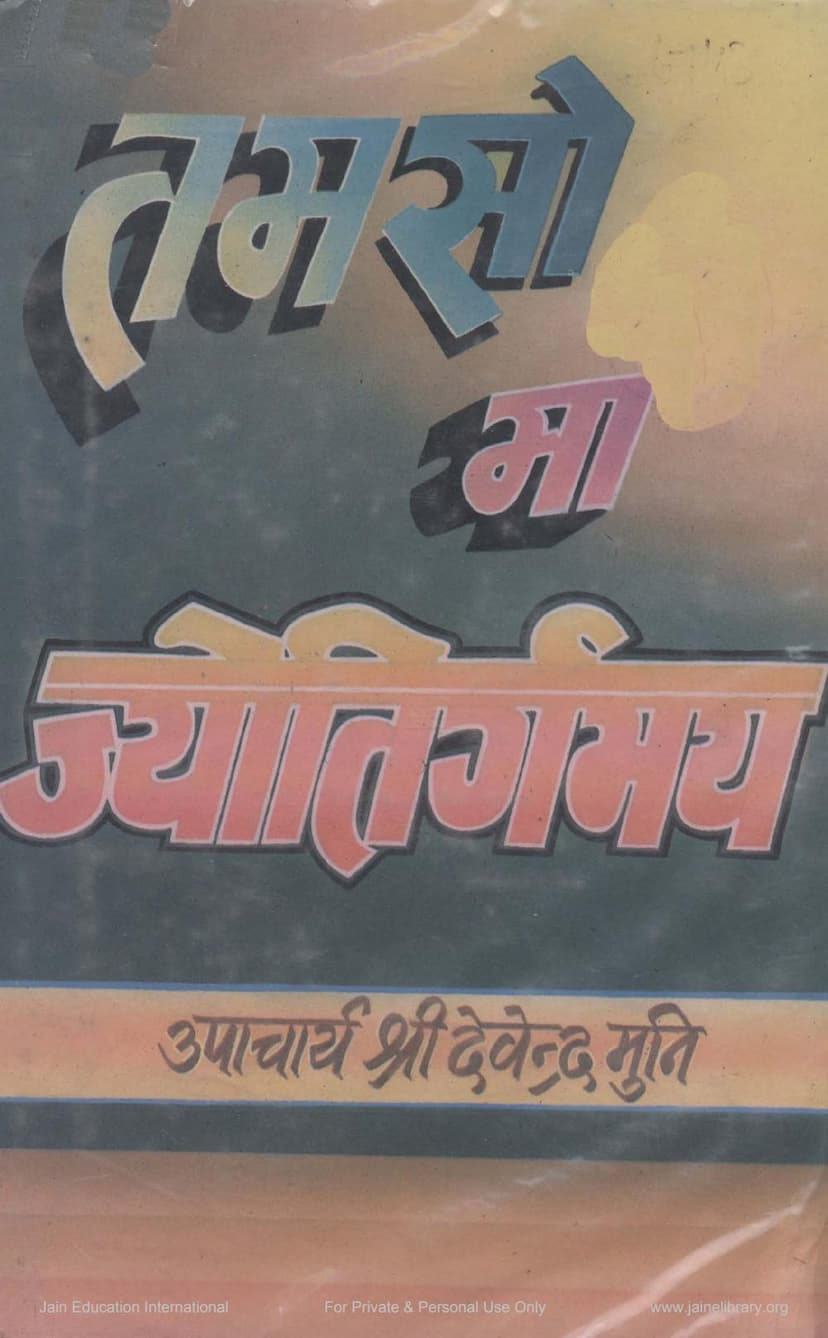Tamso Ma Jyotirgamayo
Added to library: September 2, 2025
Loading image...

Summary
This Jain text, titled "Tamso Ma Jyotirgamayo" (From Darkness, Lead me to Light), is a collection of contemplative essays by Upacharya Shri Devendra Muni. Published by Shri Tarak Guru Jain Granthalay in Udaipur, the book is presented as the 285th publication of the library.
Key aspects of the book summarized from the provided text:
- Author: Upacharya Shri Devendra Muni is a scholar deeply immersed in Jain scriptures, philosophy, and spirituality. He is described as a profound thinker, a prolific writer across various literary genres, a sweet-spoken individual, and a kind-hearted soul. Despite his busy schedule assisting his ailing guru, Upadhyaya Shri Pushkar Muni Maharaj, he remains dedicated to his writing.
- Inspiration: The book is dedicated to the concept of moving from ignorance and darkness to knowledge and light, a core tenet in spiritual journeys. The author's work is inspired by the teachings of the Jain tradition, emphasizing spiritual growth and understanding.
- Content: "Tamso Ma Jyotirgamayo" comprises 15 essays covering diverse spiritual and philosophical topics, including:
- The Mahamantra (Navkar Mantra) - its significance, contemplation, and practice.
- Various aspects of spiritual practice.
- The rise and fall of the soul, emphasizing self-responsibility.
- Methods for all-around self-development, particularly through austerity (Tapas).
- The roots of mental peace and the foundations of spiritual progress.
- Self-reliance and self-strength.
- The importance of self-study (Swadhyaya) for spiritual advancement.
- Core spiritual principles (Atma-bhavana).
- The victory of courage.
- The essence of altruism (Paramarth-parayanata).
- The comprehensive nature of Ahimsa (non-violence), exploring its various dimensions and distinguishing it from mere ritualistic practices.
- A detailed analysis of violence (Himsa) and non-violence (Ahimsa), including their sources and the subtle distinctions between them, especially the difference between Dravya Himsa (physical violence) and Bhava Himsa (mental or emotional violence).
- Underlying Philosophy: The book stresses that true progress is spiritual rather than merely material. It critiques the modern obsession with material advancement at the expense of spiritual and ethical development. It highlights the importance of self-effort, self-discipline, and inner transformation over external rituals or seeking external validation. The text emphasizes the concept of Atma-bal (self-strength) as the ultimate source of all capabilities and success. It also delves into the principle of Paramarth (altruism) as a sign of spiritual maturity and a means to universal well-being.
- Sponsorship: The publication was made possible through the generous support of Shri Suwalal Ji Chhallani and his wife, Smt. Tarabai Chhallani, from Aurangabad, who are described as devout and philanthropic individuals. Smt. Tarabai Chhallani's memory is honored through this publication.
- The Navkar Mantra (Chapter 1 & 2): Two chapters are dedicated to the Navkar Mantra, considered the heart of Jainism. These chapters explore its profound meaning, its scientific and spiritual significance, its structure (letters, vowels, consonants), and the philosophical underpinnings of venerating the five supreme beings (Arihants, Siddhas, Acharyas, Upadhyayas, and Sadhus). It also touches upon the yogic aspects of meditating on the mantra, associating specific colors with each of the five entities. The immense power and timeless nature of this mantra are highlighted, emphasizing its role in overcoming karmic obstacles and achieving spiritual liberation.
- Spiritual Sadhana (Chapter 3, 4, 5, 6): Several chapters focus on the practice of spiritual discipline (Sadhana). These explore its importance, the discipline required (drawing parallels with farmers and gardeners), the self-driven nature of spiritual growth, the necessity of continuous practice with patience and dedication, and the role of Tapas (austerity) in purifying the soul. It further elaborates on the foundational aspects of self-improvement, the source of strength in Atma-bal, and the core principle of self-awareness (Atma-bodh) as the first step towards self-upliftment.
- Ahimsa (Chapters 13, 14, 15): A significant portion of the book is dedicated to the comprehensive understanding and practice of Ahimsa. It distinguishes between gross physical violence (Dravya Himsa) and subtle mental violence (Bhava Himsa), emphasizing that the latter is the root cause of suffering and karmic bondage. The text clarifies that true Ahimsa lies in the absence of harmful intentions and emotions like anger, pride, deceit, and greed, rather than just external actions. It highlights the practical application of Ahimsa in daily life and critiques the misinterpretations and limitations of purely external adherence to non-violence. The distinction between Dravya Himsa and Bhava Himsa is crucial, with Bhava Himsa being considered more detrimental. The text also discusses the practical aspects of managing violence in daily life through careful conduct, Yatna (carefulness), and discerning the intensity of violence based on the complexity of the living being and the intent behind the action.
In essence, "Tamso Ma Jyotirgamayo" serves as a guide for spiritual seekers, offering profound insights into Jain philosophy and providing practical guidance for self-realization through virtuous living, diligent practice, and the unwavering pursuit of truth and non-violence.